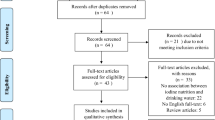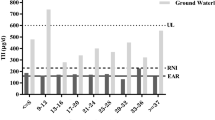Abstract
Urinary iodide and iodine in drinking water were determined in 318 healthy children aged 0 to 18 yr living in Izmir and environmental rural and urban areas in the western part of Turkey. The method is based on substochiometric isotope dilution analysis. Iodide was precipitated by substoichiometric amounts of AgNO3. Iodide-131 was used as a tracer. Electrophoresis was performed to separate Ag131I from excess131I-. The Ag131I zone was cut off the electrophoresis paper and counted with a Nal(Tl) scintillation counter. Count rates were plotted versus added KI concentrations. The unknown iodide amount was found by using these linear plots. Iodide concentration ranges were within 1.8 –100.45 Μg/L in the analyzed drinking water samples. The mean value was 44.14 ±17.33 Μg/L and the median was 58.08 Μg/L. Urinary iodide concentration ranges were 0.22 –142.22 Μg/L. The median of the distribution was 37.71 Μg/L and the mean was 40.30 ±24.05 Μg/L. The results show that the examined area suffers moderate iodine deficiency.
Similar content being viewed by others
References
B. A. Lamberg, Iodine deficiency disorders and endemic goitre,Eur. J. Clin. Nutr. 47, 1–8 (1993).
H. J. Biersack and F. Grunwald, Endocrinological applications in nuclear medicine,Semin. Nucl. Med. 25(2), 92–110 (1995).
World Health Organization Report, Trace elements in human nutrition on health, WHO (1996), pp. 49–59.
J. T. Dunn, Seven deadly sins in confronting endemic iodine deficiency, and how to avoid them,J. Clin. Endocr. Metab. 81(4), 1332–1335 (1996)
O. Ali, Iodine deficiency disorders: a public health challenge in developing countries,Nutrition 11(5) (Suppl.), 517–519 (1995).
B. S. Hetzel, Iodine deficiency: a global problem,MJA 165, 28–29 (1996).
P. Valeix, P. Preziosi, C. Rossgnol, M. A. Farmer, and S. Hercberg, Iodine intakes assessed by urinary iodine concentrations in healthy children aged ten months, two years, and four years,Biol. Trace Element Res. 32, 259–266 (1992).
J. Rendl, D. Bier, T. Groh, and C. Reiners, Rapid urinary iodide test,J. Clin. Endocr. Metab. 83(3), 1007–1012 (1998).
J. Rendl, S. Seybold, and W. Börner, Urinary iodide determined by paired-ion reversed-phase HPLC with electrochemical detection,Clin. Chem. 4016, 908–913 (1994).
P. Allain, Y. Mouras, C. Douge, L. Jaunault, T. Delaporte, and C. Beaugrand, Determination of iodine and bromine in plasma and urine by inductively coupled plasma mass spectrometry,Analyst 115, 813–815 (1990).
V. S. Burakov, A. V. Isaevich, P. Ya. Misakov, P. A. Naumenkov, and S. N. Raikov, Intracavity laser spectroscopic method for determining trace amounts of iodine and barium in water and biological samples,J. Anal. Atomic Spectrom. 9, 307–309 (1994).
M. Mwaura, D. G. S. Narayana, and A. M. Kinyua, Sample preparation technique for iodine determination in urine and water samples,J. Trace Element Electrolytes Health Dis. 8, 115–117 (1994).
Bilabina, M. Braizer, H. Bour, A. Dohl, and G. Desmet, Evaluation of iodide deficiency in Togo using an optimized potentiometric method for iodide estimation in urine,Ann. Biol. Clin. 52, 261–264 (1994).
M. Pesavento and A. Profumo, General procedure for the determination of trace amounts of iodine in natural water samples of unknown composition by spectrophotometric titration,Analyst 110, 181–183 (1985).
M. M. Mason, V. L. Spate, I. S. Morris, C. K. Baskett, T. P. Cheng, C. L. Reams, et al., Determination of iodine in urine, using epithermal instrumental neutron activation analysis (EINAA), at the University of Missouri Research Reactor (MURR),J. Radional. Nucl. Chem. 195(1), 57–65 (1995).
V. Singh and A. N. Garg, Sub-stoichiometric isotope dilution analysis method for the determination of iodine in common salts using iodine-131 tracer,Analyst 119, 1417–1419 (1994).
H. özakay, P. ünak, Z. Biber, and F. Yurt, Determination of iodide in drinking water by isotope dilution analysis,J. Radioanal. Nucl. Chem. 230(1–2), 231–233 (1998).
Z. Biber, H. özakay, P. ünak, and F. Yurt, Determination of iodide amounts in common salts by isotope dilution analysis in Turkey,J. Radioanal. Nucl. Chem. 240(1), 395–396 (1999).
Ş. Can, Ş. Darcan, M. Çoker, M. Yalaz, Z. Orbak, E. Mavi, Thyroid function tests in prepuberal children in endemic goiter area, II, National Pediatric Endocrinology Congress, Izmir, Turkey, October (1997), 8–10 p. P-12.
Author information
Authors and Affiliations
Rights and permissions
About this article
Cite this article
Unak, P., Darcan, Ş., Yurt, F. et al. Determination of iodide amounts in urine and water by isotope dilution analysis. Biol Trace Elem Res 71, 463–470 (1999). https://doi.org/10.1007/BF02784234
Issue Date:
DOI: https://doi.org/10.1007/BF02784234




